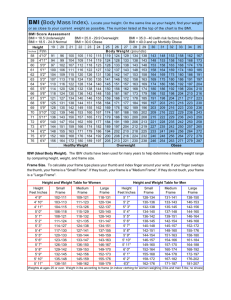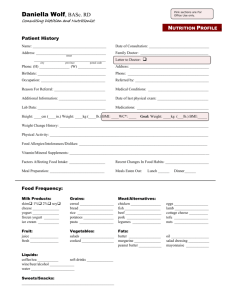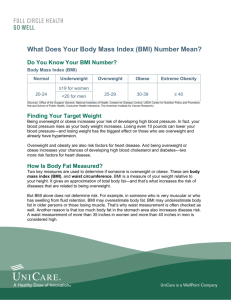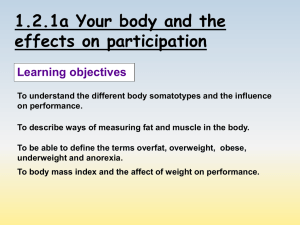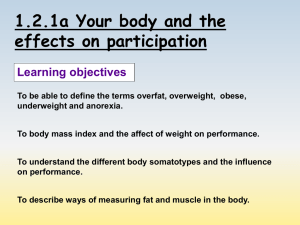Lab3 Body Comp
advertisement
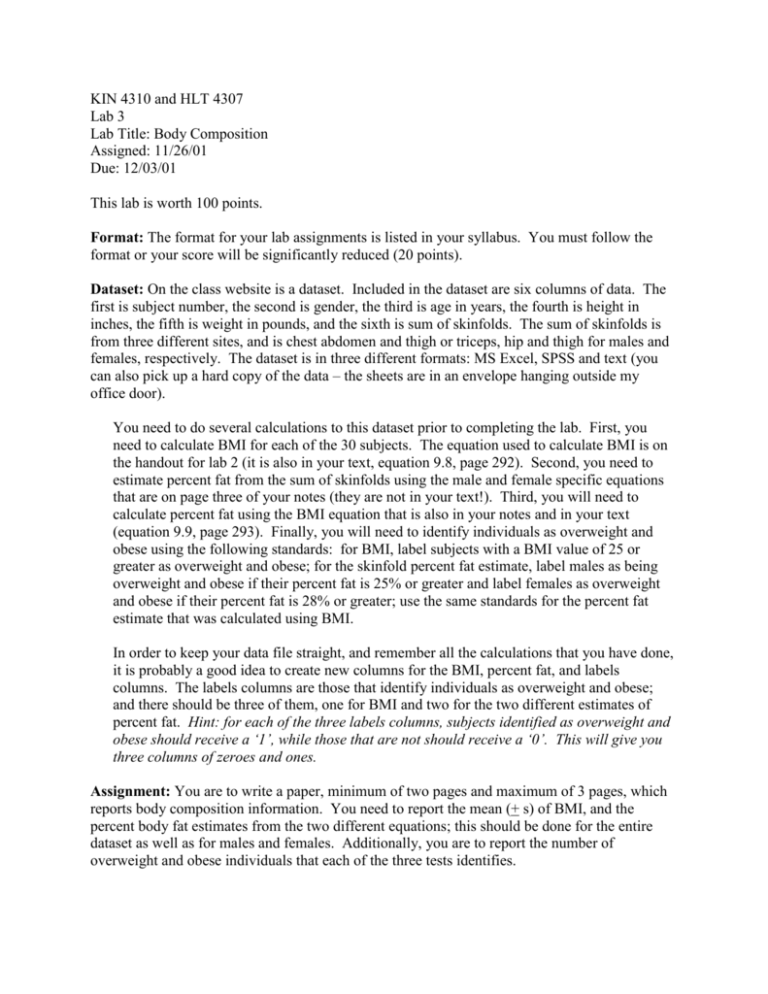
KIN 4310 and HLT 4307 Lab 3 Lab Title: Body Composition Assigned: 11/26/01 Due: 12/03/01 This lab is worth 100 points. Format: The format for your lab assignments is listed in your syllabus. You must follow the format or your score will be significantly reduced (20 points). Dataset: On the class website is a dataset. Included in the dataset are six columns of data. The first is subject number, the second is gender, the third is age in years, the fourth is height in inches, the fifth is weight in pounds, and the sixth is sum of skinfolds. The sum of skinfolds is from three different sites, and is chest abdomen and thigh or triceps, hip and thigh for males and females, respectively. The dataset is in three different formats: MS Excel, SPSS and text (you can also pick up a hard copy of the data – the sheets are in an envelope hanging outside my office door). You need to do several calculations to this dataset prior to completing the lab. First, you need to calculate BMI for each of the 30 subjects. The equation used to calculate BMI is on the handout for lab 2 (it is also in your text, equation 9.8, page 292). Second, you need to estimate percent fat from the sum of skinfolds using the male and female specific equations that are on page three of your notes (they are not in your text!). Third, you will need to calculate percent fat using the BMI equation that is also in your notes and in your text (equation 9.9, page 293). Finally, you will need to identify individuals as overweight and obese using the following standards: for BMI, label subjects with a BMI value of 25 or greater as overweight and obese; for the skinfold percent fat estimate, label males as being overweight and obese if their percent fat is 25% or greater and label females as overweight and obese if their percent fat is 28% or greater; use the same standards for the percent fat estimate that was calculated using BMI. In order to keep your data file straight, and remember all the calculations that you have done, it is probably a good idea to create new columns for the BMI, percent fat, and labels columns. The labels columns are those that identify individuals as overweight and obese; and there should be three of them, one for BMI and two for the two different estimates of percent fat. Hint: for each of the three labels columns, subjects identified as overweight and obese should receive a ‘1’, while those that are not should receive a ‘0’. This will give you three columns of zeroes and ones. Assignment: You are to write a paper, minimum of two pages and maximum of 3 pages, which reports body composition information. You need to report the mean (+ s) of BMI, and the percent body fat estimates from the two different equations; this should be done for the entire dataset as well as for males and females. Additionally, you are to report the number of overweight and obese individuals that each of the three tests identifies. Paper: Your paper should have four different sections: introduction; methods; results and conclusions. The introduction section should introduce me to the topic of your paper and why it should be done (why is it important that you evaluate different methods of estimating body composition?). This section should be three to four sentences long (the very first sentence should start: “The purpose of this paper is to compare the results of different methods of estimating body composition to determine…”). The methods section should inform me of how you estimated body composition. BMI is self-explanatory; however, for the percent fat estimates, I need the sites that were used and the methods that were used to estimate percent fat (i.e., which equation?). This section should be six to eight sentences long. The results section should report the means and standard deviations of BMI and the two estimates of percent fat. You should have three tables; one for the entire dataset and one each for males and females. Additionally, you should also report the percentage of individuals identified as overweight and obese (which is the number identified divided by the total number – this does not have to be broken down by male and female, just for the whole group). The conclusions section should be an overall wrap-up of the paper. Included in this section should be what you think about the different methods of estimating body composition and whether or not any trends exist in the data. You should also elaborate on why the percent fat estimates are not identical; do this from a reliability and validity perspective. Finally, if any trends are present, explain what you think may have caused them. Bonus – 50 points: If you were tasked with evaluating the validity of the percent fat estimate that used BMI, how would you go about doing this? The majority of the information that you need to answer this question has already been calculated. In order to receive the full 50 points, you need to identify your criterion measure and how you will determine validity. Also, you need to let me know how you will make your validity decision. All of this information should be provided in the context of the results and conclusions sections of your lab. I am looking for a specific method of validation; however, that does not preclude other approaches. You need to convince me that your method of validation is appropriate. Hint: think of a way to use the labels columns. Table 1. Mean and standard deviation of BMI and two estimates of percent fat for entire dataset. Parameter BMI Percent Fat-Skinfolds Percent Fat-BMI Mean Standard Deviation




